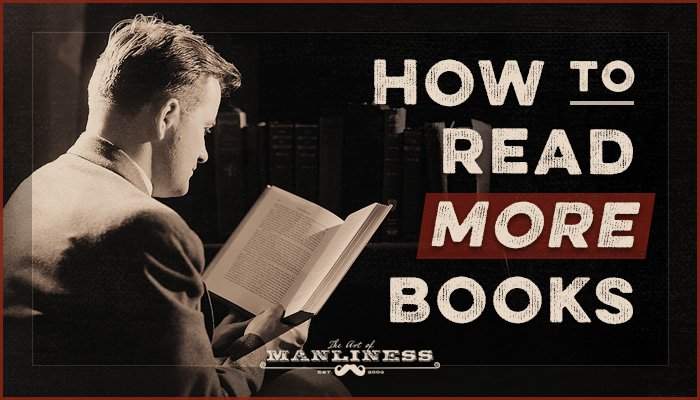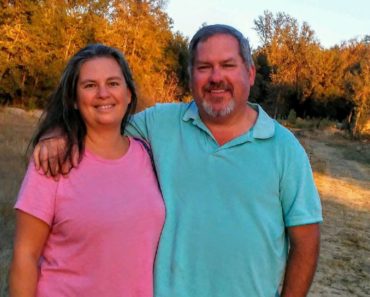
Last year I read over 120 books. When I posted a collage of my favorite of those 120 reads on Instagram, a lot of guys asked me what my secret was for digesting that many tomes in 12 months.
I’ve developed some tactics during my years of reading for both work and pleasure, and I share them below. If you’re looking to increase your physical and mental library and read more books this year, maybe they’ll work for you too.
The Biggest Trick to Reading More
When people ask me how I read so many books, they’re usually fishing for a speed reading technique that will allow their brains to swallow books whole.
Speed reading certainly plays a role in my reading technique (more on that later), but it’s not my killer secret.
Lean in. I’m going to whisper the secret to reading a lot of books.
Are you ready?
You need to spend more time reading.
I spend a lot of time reading because it’s part of my job.
To prepare for my podcast, I read my guest’s book(s). When I write articles, I read books for research. Reading is just part of my job description.
Being amazed at how many books I read in a year would be like being amazed at how many leaky faucets a plumber fixed in a year. It’s not that impressive when it’s what you do for work.
With that said, in addition to the books I read specifically for the Art of Manliness last year, I also managed to read 2-3 books every month for pleasure. That’s more than two dozen non-work related books in 12 months. It’s an amount that I think most men with even the busiest of schedules can very viably knock off in a year too.
So the #1 secret to reading more is to spend more time reading.
How can you find this time?
Schedule time for reading. You can’t in fact find time for reading; you’ve got to make time for it. And the best way to make time for something is to put it on your daily schedule. You don’t need to set aside an hour straight for reading. If you’re just starting off with making reading a priority, you probably don’t yet have the attention span for it, and trying to read that long in one sitting will likely set you up for frustration. Instead, block off 30 minutes in the morning and 30 minutes at night for reading. Heck, make those 20-minute blocks if a half hour still seems too long. Instead of doing your typical time-wasting smartphone scan at those times, you’ll read. You’ll be amazed how many books you can knock off in a month by reading an hour a day.
Use spare moments for reading. Even though your daily schedule may seem packed, there are invariably small pockets of time hidden in its interstices that you typically waste. A few minutes of downtime between activities or appointments may seem trivial, but they soon add up to hours, and to entire books read; there’s great possibilities in spare moments!
Standing in line at the post office? Read a book. Cooling your heels at the dentist? Read a book. Pooping? Read a book. Waiting to pick up your kid from school? Read. I’ll even read in between sets while I’m lifting weights. #barbellsandbooks
The easiest way to be ready to read when you find yourself with a little slice of time is to download the Kindle app on your phone. You almost always have your phone with you, and will thus almost always have a library at your fingertips. (And on the cheap if you want; you can get thousands of classics for free.)
Avoid reading on your smartphone. So I just recommended using the Kindle app on your smartphone to get more reading done. Now I’m going to completely contradict that advice by recommending you avoid reading on your smartphone as much as possible.
Let me explain.
I’ve found that when I read on my phone, I tend to get really distracted. I’ll read for 5 minutes, but then get the itch to check my email or scroll through Instagram. I’ll do a quick check of other apps and then get back to reading. Five minutes later the itch comes back, and I repeat the cycle. I never get in any good, focused reading when I read on my phone.
Consequently, I try to do most of my reading with physical books. What’s more, studies suggest that reading comprehension increases when you read an analog book compared to reading on digital devices. It’s probably because you simply focus more when using the former medium.
The other advantage of paper books is that I find it easier to highlight and make notes compared to e-readers (more on that below, too).
While I try to do most of my reading with physical books, digital books still have a place in my reading schedule. I use the Kindle app for spare moment reading and nothing more. A spare “moment” lasts about 5-15 minutes, or about the amount of time I can read on my phone before the itch to check another app arises.
Of course, I read different books on my phone and in paperback; it would be a huge pain in the rear to try to switch back and forth between a digital and hard copy of the very same book. At any given time, I’ll be reading one book as a paperback, and a different book on my Kindle app, often picking a “lighter” book for the latter selection, since I won’t be engaging it with as much sustained attention.
Take advantage of travel time. If you commute by subway or bus, use that travel time to read. Before our managing editor Jeremy started working for AoM, he took a bus every day to work and used that time to read. He was able to finish several books during those commutes.
My favorite time to get reading done is when I’m on a plane. You’d be surprised how much reading you can accomplish during a two-hour flight in the absence of Wi-Fi-dependent distractions. In fact, you can finish entire books from beginning to end in that amount of time. Short books, of course. I’ve read The Road, The Great Gatsby, Death of a Salesman, The Bhagavad Gita, and The Innovator’s Dilemma all on 2-hour trips.
Next time you’re traveling by plane, instead of loading your phone with apps and movies, stock it with books. Better yet, bring a physical book or two in your carry-on.
Listen to audiobooks. I don’t listen to too many audiobooks; it’s just not my preferred method of consuming literature. But if I’m going on a long road trip where I’ll be doing most of the driving, I’ll buy a few on Audible to pass the time. If you’re on the road a lot, your drive can be a golden opportunity to consume a big ol’ library of books.
Pro-tip: speed up the narration to 1.5x or 2x. You can still understand everything, but it will allow you to get through a book much faster.
Speed read strategically. As mentioned above, when people ask me how I read so many books, they often assume I’m speed reading. But when I utilize the reading methods above, I’m typically reading at a fairly normal pace (I think my normal pace is a little faster than average, but it’s not so fast it would qualify as speed reading).
Speed reading courses will claim that you can have fantastic comprehension while reading a million words a minute. It’s not true. While it is possible, with lots of practice, to increase reading speed while maintaining decent comprehension, there’s inevitably going to be some comprehension loss the faster you go. For that reason, I don’t like speed reading.
With that said, I do occasionally speed read or skim books. But I do so strategically.
Certain kinds of books lend themselves well to speed reading. Specifically, business books and “pop-y” self-development books — the kind of books you’d grab at the front of an airport bookstore. These genres of books are typically formatted for easy scanning. They make extensive use of headings, bolded first sentences, and bulleted lists. You can read and scan through these books pretty quick and still get what they’re about. The extra text in them often doesn’t actually add very much to the main points; it typically consists of anecdotes that demonstrate how a certain principle was put into action. Such stories can be interesting, but they’re often just fluff.
The other reason these pop self-improvement/business books are so easy to speed read is that they all pretty much say the same thing. If you’ve read one personal development book you’ve read them all. I can’t count the number I’ve read that have referenced the marshmallow test or that “invisible” gorilla on the basketball court study. As soon as I see “marshmallow test” in a book, I’m skipping all the pages that describe the experiment and the obligatory explanation on the importance of delayed gratification because I’ve already read about it a bajillion times.
While I’ll speed read/scan business and personal development books, I don’t speed read stuff that requires concentration and attention to understand fully, like works of philosophy, history, or science. For example, Alistair MacIntyre’s After Virtue is super hard to understand when you’re reading it at a snail’s pace; it’d be impossible to comprehend if you sped through it.
I also don’t speed read fiction. First, with fiction, there’s a lot of nuance in the story that can be lost if you skim it. Second, fiction is often filled with literary flourishes that must be read slowly and deliberately to really be absorbed and appreciated. If you’re speed reading Dickens or Austen (yes, there’s a place for Jane Austen in a man’s library), you’re going to miss out on prose that should be relished. Finally, reading fiction is supposed to be enjoyable. Why would you want to rush through a pleasant experience as quickly as possible? I remember how bummed I felt when I finished Lonesome Dove the first time; I just wanted it to keep going and going.
So yes, speed read — but only occasionally and strategically.
Taking Notes and Remembering What You Read
Another question I often get in conjunction with how I read so much is if I have a note-taking system.
I do – but it’s nothing flashy and may not even qualify as a “system.” If I’m reading a physical book, I underline sentences; put brackets around key paragraphs; and if there’s a point that I think is really important, I’ll put a star next to it. When I’m done with a book, I’ll skim through it again and review my notes.
If I’m on a Kindle, I just highlight passages and review those highlights when I finish reading the book. I sometimes also download those notes and save them on my computer.
That’s how I take notes. Stupidly simple. Use what works for you.
A final question I often get asked about my reading is how I remember everything that I read.
Short answer: I don’t! I just try to remember the things that are important to me. I mentally solidify those important things in a few ways.
The biggest key to remembering what you read is to synthesize and apply it as quickly as you can. For me, that means I’m either writing an article or coming up with podcast questions based on my reading notes. Those two acts help me better remember the things I just read about.
With books I read for pleasure, I’ll share some of their interesting tidbits with Kate or a friend. I much more readily retain the things I talk over with others.
Another way I remember what I read is through repetition. As I’ve spent years reading a lot, I’ve seen the same ideas come up over and over again. For example, I know a lot about WWII history because I’ve read a lot of books about WWII. I know a lot about Theodore Roosevelt because I’ve read a lot of books about Theodore Roosevelt. I know quite a bit about psychology because I’ve read a lot of psychology books. And when it comes to the self-help genre, while it’s beneficial to hear different authors’ angles on things, there’s really not much new under the sun! Each time you pass over the same ideas and sets of facts — put in slightly varied ways and contexts — they become more and more solidified in your brain.
So if you want to remember what you’ve read, find ways to synthesize, apply, and talk about it soon afterwards. That could mean writing a book report summarizing the key takeaways or bringing up some idea from a book in conversation with your friends. Heck, send out an email newsletter of your reading; this is what Jeremy does, and he said it’s helped him enormously in retaining a book’s main ideas, and synthesizing and coming to a concrete opinion on it.
The other way to remember more of what you read is to simply read more about that particular topic until it’s well rooted in your brain.
Well, there you go. How I get so much reading done and how I remember what I read. There’s really no secret. Read a lot. Apply what you read. Rinse and repeat.
Here’s to more reading this year and beyond!
The post How to Read More Books appeared first on The Art of Manliness.
(via The Art of Manliness)






